Perioperative enhanced recovery programmes for women with gynaecological cancers
- PMID: 35289396
- PMCID: PMC8922407
- DOI: 10.1002/14651858.CD008239.pub5
Perioperative enhanced recovery programmes for women with gynaecological cancers
Abstract
Background: Gynaecological cancers account for 15% of newly diagnosed cancer cases in women worldwide. In recent years, increasing evidence demonstrates that traditional approaches in perioperative care practice may be unnecessary or even harmful. The enhanced recovery after surgery (ERAS) programme has therefore been gradually introduced to replace traditional approaches in perioperative care. There is an emerging body of evidence outside of gynaecological cancer which has identified that perioperative ERAS programmes decrease length of postoperative hospital stay and reduce medical expenditure without increasing complication rates, mortality, and readmission rates. However, evidence-based decisions on perioperative care practice for major surgery in gynaecological cancer are limited. This is an updated version of the original Cochrane Review published in Issue 3, 2015.
Objectives: To evaluate the beneficial and harmful effects of perioperative enhanced recovery after surgery (ERAS) programmes in gynaecological cancer care on length of postoperative hospital stay, postoperative complications, mortality, readmission, bowel functions, quality of life, participant satisfaction, and economic outcomes.
Search methods: We searched the following electronic databases for the literature published from inception until October 2020: Cochrane Central Register of Controlled Trials (CENTRAL), MEDLINE, Embase, PubMed, AMED (Allied and Complementary Medicine), CINAHL (Cumulative Index to Nursing and Allied Health Literature), Scopus, and four Chinese databases including the China Biomedical Literature Database (CBM), WanFang Data, China National Knowledge Infrastructure (CNKI), and Weipu Database. We also searched four trial registration platforms and grey literature databases for ongoing and unpublished trials, and handsearched the reference lists of included trials and accessible reviews for relevant references.
Selection criteria: We included randomised controlled trials (RCTs) that compared ERAS programmes for perioperative care in women with gynaecological cancer to traditional care strategies.
Data collection and analysis: Two review authors independently screened studies for inclusion, extracted the data and assessed methodological quality for each included study using the Cochrane risk of bias tool 2 (RoB 2) for RCTs. Using Review Manager 5.4, we pooled the data and calculated the measures of treatment effect with the mean difference (MD), standardised mean difference (SMD), and risk ratio (RR) with a 95% confidence interval (CI) to reflect the summary estimates and uncertainty.
Main results: We included seven RCTs with 747 participants. All studies compared ERAS programmes with traditional care strategies for women with gynaecological cancer. We had substantial concerns regarding the methodological quality of the included studies since the included RCTs had moderate to high risk of bias in domains including randomisation process, deviations from intended interventions, and measurement of outcomes. ERAS programmes may reduce length of postoperative hospital stay (MD -1.71 days, 95% CI -2.59 to -0.84; I2 = 86%; 6 studies, 638 participants; low-certainty evidence). ERAS programmes may result in no difference in overall complication rates (RR 0.71, 95% CI 0.48 to 1.05; I2 = 42%; 5 studies, 537 participants; low-certainty evidence). The certainty of evidence was very low regarding the effect of ERAS programmes on all-cause mortality within 30 days of discharge (RR 0.98, 95% CI 0.14 to 6.68; 1 study, 99 participants). ERAS programmes may reduce readmission rates within 30 days of operation (RR 0.45, 95% CI 0.22 to 0.90; I2 = 0%; 3 studies, 385 participants; low-certainty evidence). ERAS programmes may reduce the time to first flatus (MD -0.82 days, 95% CI -1.00 to -0.63; I2 = 35%; 4 studies, 432 participants; low-certainty evidence) and the time to first defaecation (MD -0.96 days, 95% CI -1.47 to -0.44; I2 = 0%; 2 studies, 228 participants; low-certainty evidence). The studies did not report the effects of ERAS programmes on quality of life. The evidence on the effects of ERAS programmes on participant satisfaction was very uncertain due to the limited number of studies. The adoption of ERAS strategies may not increase medical expenditure, though the evidence was of very low certainty (SMD -0.22, 95% CI -0.68 to 0.25; I2 = 54%; 2 studies, 167 participants).
Authors' conclusions: Low-certainty evidence suggests that ERAS programmes may shorten length of postoperative hospital stay, reduce readmissions, and facilitate postoperative bowel function recovery without compromising participant safety. Further well-conducted studies are required in order to validate the certainty of these findings.
Trial registration: ClinicalTrials.gov NCT01705288 NCT03347409 NCT03667755 NCT02172638 NCT02687412 NCT02864277 NCT03640299 NCT04063072.
Copyright © 2022 The Cochrane Collaboration. Published by John Wiley & Sons, Ltd.
Conflict of interest statement
Janita Pak Chun Chau: none known Xu Liu: none known Suzanne Hoi Shan Lo: none known Wai Tong Chien: none known Sze Ki Hui: none known Kai Chow Choi: none known Jie Zhao: none known
Figures


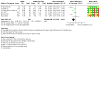
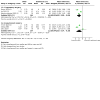

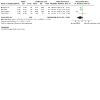
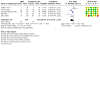
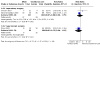
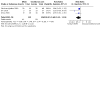


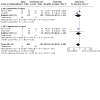


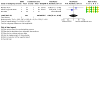



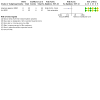



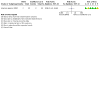








Update of
-
Perioperative enhanced recovery programmes for gynaecological cancer patients.Cochrane Database Syst Rev. 2015 Mar 19;2015(3):CD008239. doi: 10.1002/14651858.CD008239.pub4. Cochrane Database Syst Rev. 2015. Update in: Cochrane Database Syst Rev. 2022 Mar 15;3:CD008239. doi: 10.1002/14651858.CD008239.pub5. PMID: 25789452 Free PMC article. Updated.
References
References to studies included in this review
Dickson 2017 {published data only}
Ferrari 2020 {published data only}
Ho 2020 {published data only}
-
- Ho CY, Ibrahim Z, Zaid ZA, Daud ZA, Yusop NB, Omar J, et al.Impact of enhanced recovery after surgery with preoperative whey protein-infused carbohydrate loading and postoperative early oral feeding among surgical gynecologic cancer patients: an open-labelled randomized controlled trial. Nutrients 2020;12:264. [DOI: 10.3390/nu12010264] - DOI - PMC - PubMed
-
- Ho CY, Ibrahim Z, Zaid ZA, Daud ZA, Yusop NB.Fast-track-recovery surgery with a whey protein-infused carbohydrate-loading drink pre-operatively and early oral feeding postoperatively among surgical gynaecological cancer patients: Study protocol of an open labelled, randomised controlled trial. Trials 2020;21:533. [DOI: 10.1186/s13063-020-04462-4] - DOI - PMC - PubMed
Sánchez‐Iglesias 2020 {published data only}
-
- Sánchez-Iglesias JL, Carbonell-Socias M, Pérez-Benavente MA, Clua SM, Manrique-Muñoz S, Gorriz MG, et al.PROFAST: a randomised trial implementing enhanced recovery after surgery for high complexity advanced ovarian cancer surgery. European Journal of Cancer 2020;136:149-158. [DOI: 10.1016/j.ejca.2020.06.011] - DOI - PubMed
Shi 2020 {published and unpublished data}
Zhang 2016 {published data only}
-
- Zhang SM, Wang YK, Chen L.Effect of fast track surgery on immune function after laparoscopic radical hysterectomy in patients with cervical cancer. Chinese Journal of Practical Gynecology and Obstetrics 2015;31(8):754-8.
-
- Zhang SM.The effect of enhanced recovery after surgery on patients undergoing laparoscopic radical resection of cervical cancer [Doctoral dissertation]. China, Qingdao: Qingdao University, 2016. [cdmd.cnki.com.cn/Article/CDMD-11065-1016772898.htm]
Zhou 2020 {published data only}
-
- Zhou Y, Liu Y, Jiang H, Zhou Y, Zhou S.Application of enhanced recovery after surgery nursing in patients with minimally invasive surgery of gynecological malignant tumors. Chinese Journal of Modern Nursing 2020;26(12):1582-6. [DOI: 10.3760/cma.j.cn115682-20190716-02531] - DOI
References to studies excluded from this review
Agarwal 2019 {published data only}
-
- Agarwal R, Rajanbabu A, Nitu PV, Goel G, Madhusudanan L, Unnikrishnan UG.A prospective study evaluating the impact of implementing the ERAS protocol on patients undergoing surgery for advanced ovarian cancer. International Journal of Gynecological Cancer 2019;29:605-12. - PubMed
Belavy 2013 {published data only}
-
- Belavy D, Janda M, Baker J, Obermair A.Epidural analgesia is associated with an increased incidence of postoperative complications in patients requiring an abdominal hysterectomy for early stage endometrial cancer. Gynecologic Oncology 2013;131(2):423-9. - PubMed
Bergstrom 2018 {published data only}
-
- Bergstrom JE, Scott ME, Alimi Y, Yen T-T, Hobson D, Machado KK, et al.Narcotics reduction, quality and safety in gynecologic oncology surgery in the first year of enhanced recovery after surgery protocol implementation. Gynecologic Oncology 2018;149:554-9. - PubMed
Bernard 2021 {published data only}
Bisch 2018 {published data only}
-
- Bisch SP, Wells T, Gramlich L, Faris P, Wang X, Tran DT, et al.Enhanced Recovery After Surgery (ERAS) in gynecologic oncology: system-wide implementation and audit leads to improved value and patient outcomes. Gynecologic Oncology 2018;151:117-23. - PubMed
Boitano 2018 {published data only}
-
- Boitano TK, Smith HJ, Rushton T, Johnston MC, Lawson P, Leath CA, et al.Impact of enhanced recovery after surgery (ERAS) protocol on gastrointestinal function in gynecologic oncology patients undergoing laparotomy. Gynecologic Oncology 2018;151:282-6. - PubMed
Chapman 2016 {published data only}
-
- Chapman JS, Roddy E, Ueda S, Brooks R, Chen LL, Chen LM.Enhanced recovery pathways for improving outcomes after minimally invasive gynecologic oncology surgery. Obstetrics and Gynecology 2016;128:138-44. - PubMed
deGroot 2014 {published data only}
-
- Groot JJ, Es LE, Maessen JM, Dejong CH, Kruitwagen RF, Slangen BF.Diffusion of enhanced recovery principles in gynecologic oncology surgery: is active implementation still necessary? Gynecologic Oncology 2014;134:570-5. - PubMed
Eberhart 2008 {published data only}
-
- Eberhart LH, Koch T, Ploger B, Wagner U, Wulf H, Zwiorek L, et al.Enhanced recovery after major gynaecological surgery for ovarian cancer - an objective and patient-based assessment of a traditional versus a multimodal "fast track" rehabilitation programme. Anasthesiologie und Intensivmedizin 2008;49(4):180-94.
Feng 2008 {published data only}
-
- Feng S, Chen L, Wang G, Chen A, Qiu Y.Early oral intake after intra-abdominal gynecological oncology surgery. Cancer Nursing 2008;31(3):209-13. - PubMed
Gerardi 2008 {published data only}
-
- Gerardi MA, Santillan A, Meisner B, Zahurak ML, Diaz Montes TP, Giuntoli RL 2nd, et al.A clinical pathway for patients undergoing primary cytoreductive surgery with rectosigmoid colectomy for advanced ovarian and primary peritoneal cancers. Gynecologic Oncology 2008;108(2):282-6. - PubMed
Janda 2014 {published data only}
-
- Janda M, Graves N, Bauer J, Baker J, Obermair A.Quality of life and nutritional status after early enteral feeding versus standard care after surgery for advanced epithelial ovarian cancer. International Journal of Gynecological Cancer 2014;24(9):45.
Kalogera 2013 {published data only}
Kay 2020 {published data only}
Lambaudie 2017 {published data only}
Marx 2006 {published data only}
-
- Marx CI, Rasmussen T, Jakobsen DH, Ottosen C, Lundvall L, Ottesen BS, et al.Accelerated course after operation for ovarian cancer. Ugeskrift for Laeger 2006;168:1533-6. - PubMed
-
- Marx CI, Rasmussen T, Jakobsen DH, Ottosen C, Lundvall L, Ottesen BS, et al.The effect of accelerated rehabilitation on recovery after surgery for ovarian malignancy. Acta Obstetricia et Gynecologica 2006;85:488-92. - PubMed
Mendivil 2018 {published data only}
-
- Mendivil AA, Busch JR, Richards DC, Vittori H, Goldstein BH.The impact of an enhanced recovery after surgery program on patients treated for gynecologic cancer in the community hospital setting. International Journal of Gynecological Cancer 2018;28:581-5. - PubMed
Meyer 2018 {published data only}
Miller 2015 {published data only}
-
- Miller EC, McIsaac DI, Chaput A, Antrobus J, Shenassa H, Lui A.Increased postoperative day one discharges after implementation of a hysterectomy enhanced recovery pathway: a retrospective cohort study. Journal Canadien d'Anesthesie 2015;62(5):451-60. - PubMed
Mukhopadhyay 2015 {published data only}
Myriokefalitaki 2016 {published data only}
-
- Myriokefalitaki E, Smith M, Ahmed AS.Implementation of enhanced recovery after surgery (ERAS) in gynaecological oncology. Archives of Gynecology and Obstetrics 2016;294:137-43. - PubMed
Pather 2011 {published data only}
-
- Pather S, Loadsman JA, Mansfield C, Rao A, Arora V, Philp S, et al.Perioperative outcomes after total laparoscopic hysterectomy compared with fast-track open hysterectomy - a retrospective case-control study. Australian and New Zealand Journal of Obstetrics and Gynaecology 2011;51(5):393-6. - PubMed
Renaud 2019 {published data only}
-
- Renaud MC, Belanger L, Lachapelle P, Gregoire J, Sebastianelli A, Plante M.Effectiveness of an enhanced recovery after surgery program in gynaecology oncologic surgery: a single-centre prospective cohort study. Journal of Obstetrics and Gynaecology Canada 2019;41:436-42. - PubMed
Sanad 2019 {published data only}
-
- Sanad AS, El-Gindi E, El-Khateeb RR, Abdl-Ghany AM, Abdelrazik A, Mousa A, et al.Implementation of enhanced recovery after surgery for endometrial carcinoma: a non-randomized controlled trial. Indian Journal of Public Health Research and Development 2019;10:1979-84.
Schwartz 2019 {published data only}
-
- Schwartz AR, Lim S, Broadwater G, Cobb L, Valea F, Marosky Thacker J, et al.Reduction in opioid use and postoperative pain scores after elective laparotomy with implementation of enhanced recovery after surgery protocol on a gynecologic oncology service. International Journal of Gynecological Cancer 2019;29:935-43. - PubMed
Shen 2019 {published data only}
-
- Shen X.The application of enhanced recovery after surgery in laparoscopic radical hysterectomy of cervical cancer [Masters thesis]. China, Chongqing: Chongqing Medical University, 2019. [cdmd.cnki.com.cn/Article/CDMD-10631-1019660791.htm]
Wijk 2014 {published data only}
-
- Wijk L, Franzen K, Ljungqvist O, Nilsson K.Implementing a structured Enhanced Recovery after Surgery (ERAS) protocol reduces length of stay after abdominal hysterectomy. Acta Obstetricia et Gynecologica Scandinavica 2014;93(8):749-56. - PubMed
Zhang 2019 {published data only}
-
- Zhang CY, Ouyang L.The effect of the enhanced recovery after surgery in the radical operation of cervical cancer. Chinese Journal of Minimally Invasive Surgery 2019;19:145-8, 177.
References to ongoing studies
ChiCTR1900025117 {published data only}
-
- ChiCTR1900025117.Enhanced recovery after laparoscopic surgery (ERAS) in gynecologic oncology: a prospective, randomized controlled trial. www.chictr.org.cn/com/25/showprojen.aspx?proj=42068 (first received 12 August 2019).
NCT02864277 {published data only}
-
- NCT02864277.Enhanced recovery after surgery gynecology oncology (ERAS) [Enhanced recovery after surgery (ERAS) program versus conventional perioperative strategies in patients undergoing gynecologic oncologic surgery: A randomized controlled trial]. clinicaltrials.gov/ct2/show/NCT02864277 (first received 12 August 2016).
NCT03640299 {published data only}
-
- NCT03640299.The safety and efficacy of enhanced recovery after surgery on clinical and immune outcomes for gynecological oncology. clinicaltrials.gov/show/NCT03640299 (first received 21 August 2018).
NCT04063072 {published data only}
-
- NCT04063072.ERAS (Enhanced Recovery After Surgery) protocol omplementation in Piedmont region for hysterectomy. (ERAS-Gyneco) [ERAS (Enhanced Recovery After Surgery) protocol implementation in Piedmont region for hysterectomy of benign or malignant tumors of the uterus: A stepped-wedge cluster randomized clinical trial]. clinicaltrials.gov/show/NCT04063072 (first received 21 August 2019).
Additional references
Aasa 2013
Arbyn 2020
Ardò 2018
Arnold 2015
-
- Arnold A, Aitchison LP, Abbott J.Preoperative mechanical bowel preparation for abdominal, laparoscopic, and vaginal surgery: a systematic review. Journal of Minimally Invasive Gynecology 2015;22:737-52. - PubMed
ASAC 2017
-
- American Society of Anesthesiologists Committee.Practice guidelines for preoperative fasting and the use of pharmacologic agents to reduce the risk of pulmonary aspiration: application to healthy patients undergoing elective procedures: an updated report by the American Society of Anesthesiologists task force on preoperative fasting and the use of pharmacologic agents to reduce the risk of pulmonary aspiration. Anesthesiology 2017;126(3):376-93. - PubMed
Baimas‐George 2020
-
- Baimas-George M, Cochran A, Tezber K, Kirks RC, Addor V, Baker E, et al.A 2-year experience with enhanced recovery after surgery: evaluation of compliance and outcomes in pancreatic surgery. Journal of Nursing Care Quality 2021;36(2):E24-8. [PMID: ] - PubMed
Bhandoria 2020
-
- Bhandoria GP, Bhandarkar P, Ahuja V, Maheshwari A, Sekhon RK, Gultekin M, et al.Enhanced Recovery After Surgery (ERAS) in gynecologic oncology: an international survey of peri-operative practice. International Journal of Gynecological Cancer 2020;30:1471-8. [DOI: 10. 1136/ ijgc-2020- 001683] - PubMed
Cao 2012
-
- Cao F, Li J, Li F.Mechanical bowel preparation for elective colorectal surgery: updated systematic review and meta-analysis. International Journal of Colorectal Disease 2012;27(6):803-10. [PMID: ] - PubMed
Chambers 2014
Covidence [Computer program]
-
- Covidence.Version accessed 27 October 2020. Melbourne, Australia: Veritas Health Innovation. Available at www.covidence.org.
Dahabreh 2015
-
- Dahabreh IJ, Steele DW, Shah N, Trikalinos TA.Oral mechanical bowel preparation for colorectal surgery: systematic review and meta-analysis. Diseases of the Colon and Rectum 2015;58(7):698-707. [PMID: ] - PubMed
Debono 2019
-
- Debono B, Corniola MV, Pietton R, Sabatier P, Hamel O, Tessitore E.Benefits of Enhanced Recovery After Surgery for fusion in degenerative spine surgery: impact on outcome, length of stay, and patient satisfaction. Neurosurgical Focus 2019;46(4):E6. [PMID: ] - PubMed
De Groot 2016
GRADEpro GDT [Computer program]
-
- GRADEpro GDT.Version accessed 6 August 2016. Hamilton (ON): McMaster University (developed by Evidence Prime). Available at gradepro.org.
Hassinger 2019
Higgins 2011
Higgins 2019
-
- Higgins JP, Savović J, Page MJ, Elbers RG, Sterne JA.Chapter 8: Assessing risk of bias in a randomized trial. In: Higgins JP, Thomas J, Chandler J, Cumpston M, Li T, Page MJ, Welch VA, editors(s). Cochrane Handbook for Systematic Reviews of Interventions. 2nd edition. Chichester (UK): John Wiley & Sons, 2019:205-228.
Kalogera 2019
Kehlet 1997
-
- Kehlet H.Multimodal approach to control postoperative pathophysiology and rehabilitation. British Journal of Anaesthesia 1997;78(5):606-17. [PMID: ] - PubMed
Kehlet 2008
Ledford 2019
Leon Arellano 2020
-
- Leon Arellano M, Tejedor P, Guadalajara H, Ortega M, Garcia Olmo D, Pastor C.Evolution of perioperative quality of life in patients under enhanced recovery after surgery care in colorectal cancer. Revista espanola de enfermedades digestivas: organo oficial de la Sociedad Espanola de Patologia Digestiva 2020;112(2):127-32. [PMID: ] - PubMed
Li J 2019
Lindemann 2017
Li S 2017
Li T 2019
-
- Li T, Higgins JP, Deeks JJ, editor(s).Chapter 5: Collecting data. In: Higgins JP, Thomas J, Chandler J, Cumpston M, Li T, Page MJ, Welch VA, editors(s). Cochrane Handbook for Systematic Reviews of Interventions. 2nd edition. Chichester (UK): John Wiley & Sons, 2019:109-42.
Liu 2020
-
- Liu B, Liu S, Wang Y, Zhao L, Zheng T, Chen L, et al.Enhanced recovery after intraspinal tumor surgery: a single-institutional randomized controlled study. World Neurosurgery 2020;136:e542-52. [PMID: ] - PubMed
Li Z 2017
Ljungqvist 2017
-
- Ljungqvist O, Scott M, Fearon KC.Enhanced recovery after surgery: a review. JAMA Surgery 2017;152(3):292-8. [PMID: ] - PubMed
Lohsiriwat 2019
Luo 2018
-
- Luo D, Wan X, Liu J, Tong T.Optimally estimating the sample mean from the sample size, median, mid-range, and/or mid-quartile range. Statistical Methods in Medical Research 2018;27:1785-1805. - PubMed
Melloul 2020
-
- Melloul E, Lassen K, Roulin D, Grass F, Perinel J, Adham M, et al.Guidelines for perioperative care for pancreatoduodenectomy: enhanced recovery after surgery (ERAS) recommendations 2019. World Journal of Surgery 2020;44(7):2056-84. [PMID: ] - PubMed
Nelson 2014
Nelson 2019
-
- Nelson G, Bakkum-Gamez J, Kalogera E, Glaser G, Altman A, Meyer LA, et al.Guidelines for perioperative care in gynecologic/oncology: Enhanced Recovery After Surgery (ERAS) Society recommendations - 2019 update. International Journal of Gynecological cancer 2019;29(4):651-8. [PMID: ] - PubMed
Ni 2019
Nicholson 2014
-
- Nicholson A, Lowe MC, Parker J, Lewis SR, Alderson P, Smith AF.Systematic review and meta-analysis of enhanced recovery programmes in surgical patients. British Journal of Surgery 2014;101(3):172-88. [PMID: ] - PubMed
Page 2019
-
- Page MJ, Higgins JP, Sterne JA.Chapter 13: Assessing risk of bias due to missing results in a synthesis. In: Higgins JP, Thomas J, Chandler J, Cumpston M, Li T, Page MJ, Welch VA, editor(s). Cochrane Handbook for Systematic Reviews of Interventions Version 6.0 (updated July 2019). Cochrane, 2019. Available from training.cochrane.org/handbook.
Pisarska 2016
Ringwald 2017
Rouxel 2019
-
- Rouxel P, Beloeil H.Enhanced recovery after hepatectomy: a systematic review. Anaesthesia, Critical Care & Pain Medicine 2019;38(1):29-34. [PMID: ] - PubMed
Sekse 2019
Shakir 2017
-
- Shakir B.A systematic review on Enhanced Recovery After Surgery (ERAS) pathways designed for women undergoing elective open abdominal surgery due to advanced ovarian cancer [Masters thesis]. Lithuanian University of Health Sciences, 2017. [hdl.handle.net/20.500.12512/104524]
Smith 2014
Song 2020
-
- Song Z, Wang Y, Zhang D, Zhou Y.Enhanced Recovery After Surgery (ERAS) in gynaecology: a meta-analysis.. Authorea Preprints 23 August 2020. [DOI: 10.22541/au.159818470.01003468] - DOI
Spanjersberg 2011
Stark 2013
Wan 2014
Watson 2020
-
- Watson LJ, Ewers C.Enhanced recovery after head and neck cancer surgery: a review of current literature. Current Opinion in Otolaryngology & Head and Neck Surgery 2020;28(3):161-4. [PMID: ] - PubMed
WHO 2021
-
- World Health Organization International Agency for Research on Cancer.Globocan 2020 Population fact sheets (World) [ ]. gco.iarc.fr/today/data/factsheets/populations/900-world-fact-sheets.pdf 2021 .
Wickenbergh 2020
-
- Wickenbergh E, Nilsson L, Bladh M, Kjølhede P, Wodlin NB.Agreements on perceived use of principles for Enhanced Recovery AfterSurgery between patients and nursing staff in a gynecological ward. European Journal of Obstetrics & Gynecology and Reproductive Biology 2020;250:216-23. [DOI: 10.1016/j.ejogrb.2020.04.014] - DOI - PubMed
Wu 2019
Zalewski 2018
-
- Zalewski K, Piovano E, Razumova Z, Selcuk I, Nikolova T.Report from the 20th meeting of the European Society of Gynaecological Oncology (ESGO 2017). International Journal of Gynecological Cancer 2018;28(5):1050-3. [PMID: ] - PubMed
Publication types
MeSH terms
Associated data
LinkOut - more resources
Full Text Sources
Medical

